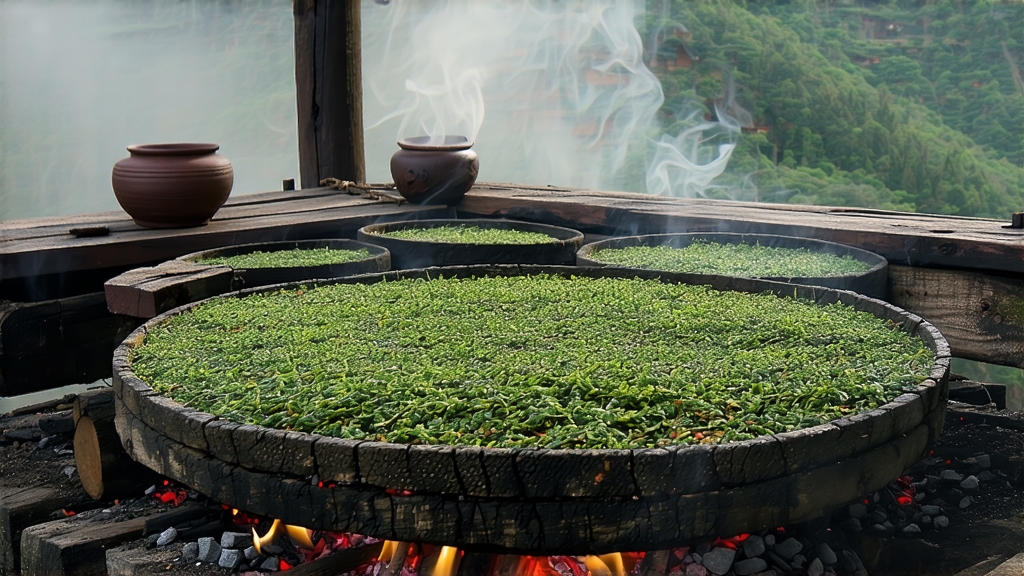
Ask most tea lovers to name the oldest black tea on earth and they will answer with a single, musical phrase: Lapsang Souchong. Born in the precipitous, pine-clad Wuyi Mountains of northern Fujian around the mid-seventeenth century, this tea predates every other fully oxidised leaf in China and, legend insists, was the first black tea ever to travel beyond the Middle Kingdom. Its very name—lapsang, “pine wood,” and souchong, “small sort”—hints at the two forces that shaped its destiny: the resinous local forests and the delicate, early-spring leaves plucked from the small-leaf tea bushes that cling to the basalt cliffs.
History
Folklore places the birth of Lapsang Souchong at Tongmu Guan, a mist-locked pass where imperial armies once guarded salt and tea caravans. In 1646, Qing troops were said to be quartered in the village; to dry the fresh leaves before the soldiers confiscated them, farmers rushed the withering baskets over smouldering pine fires. The accidental smoke infusion delighted the Dutch traders who carried the first chests to Europe, where it became the “bohea” that filled the cups of London coffee-houses and Parisian salons. By the early eighteenth century the East India Company listed “Souchon” at prices higher than green teas, cementing its role as the prototype of all black teas.
Micro-terroirs and Leaf Styles
Today the protected Tongmu National Nature Reserve—core 565 km² of primeval forest—remains the only legally recognised origin for authentic Lapsang Souchong. Within this micro-zone three elevations create distinct styles:
- River-valley (200–400 m): leaves absorb more humidity, yielding a softer, honeyed cup with gentle smoke.
- Mid-slope (400–700 m): cooler nights lengthen oxidation, giving cocoa-like depth and a lingering resin note.
- High cliff (700–1200 m): mist-shrouded bushes produce the rare “wild souchong,” tiny buds with winey sweetness and almost incense-like fragrance.
Farmers also differentiate by pluck:
– Zheng Shan Xiao Zhong: the original bud-and-two-leaf picked before Qingming festival, processed entirely with pine wood in the old way.
– Wuyi Souchong: larger leaf harvested later, lightly smoked or even baked without smoke for contemporary palates.
– Jin Jun Mei: a modern offshoot made only from buds, oxidised in bamboo trays and finished at lower temperatures; it abandons smoke for caramel and dried-longan notes while still legally qualifying as Lapsang Souchong because the leaf material comes from Tongmu.
Crafting the Smoke
Authentic production follows a six-step choreography that has changed little since the seventeenth century.
- Plucking: dawn pick of 5–6 cm shoots, carried in shallow bamboo baskets to prevent compression.
- Solar withering: leaves are laid on hemp mats for 30–40 minutes of gentle mountain sun, reducing moisture to 65 %.
- Indoor withering: transferred to the second floor of the wooden “qing lou” house, where they rest 4–6 h on racks above smouldering pine embers (28–30 °C). Smoke is minimal at this stage; heat, not flavour, is the goal.
- Rolling: when leaves feel velvety and edges redden, they are rolled for 15 minutes on rattan mats, rupturing cells to invite oxidation.
- Oxidation: rolled leaf is piled in bamboo trays inside a humid, 24 °C room. Over 3–4 h the leaf turns from jade to copper, developing malty theaflavins.
- Smoking & drying: the critical act. Fresh pine logs—preferably 30-year-old Masson and Chinese red pine—are split, partially dried, then lit and smothered to produce a cool, aromatic smoke. The tea travels on wire mesh belts through a brick oven, absorbing smoke for 2–3 minutes at 80 °C, then rests; the cycle repeats up to three times until moisture drops to 6 %. Master smokers judge by sound: properly finished leaves crunch like autumn twigs yet retain a resilient spine.
Chemical Poetry
Gas chromatography reveals the magic: guaiacol, 4-methyl-guaiacol and syringol provide the characteristic campfire note, while van